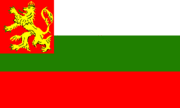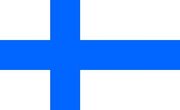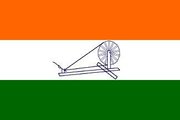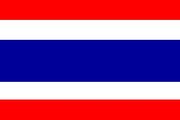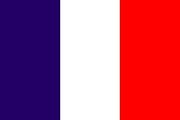Axis Powers
|
|
| Missing image Nazi_Germany_flag.JPG Nazi Germany |
| Missing image Imperial_japan.GIF Imperial Japan (Navy flag) |
| Missing image Kingdom_of_Italy_flag.JPG Kingdom of Italy |
| Missing image Hungary_1940_flag.JPG Hungary |
| Missing image Ind._St._of_Croatia_Flag.gif Independent State of Croatia |
| Missing image Manchuria_flag.JPG Manchukuo |
The Axis Powers is a term for those participants in World War II opposed to the Allies. The three major Axis powers, Germany, Italy, and Japan, referred to themselves as the Rome–Berlin–Tokyo Axis. The Axis powers ruled an empire that dominated much of the world, but were ultimately defeated in the end of World War II.
- Major Axis Powers
- Germany, under Führer-Chancellor Adolf Hitler (and in the last days of the war, President Karl Dönitz)
- Japan, under Prime Minister Hideki Tojo (and in the last days of the war, Kuniaki Koiso and Kantaro Suzuki) and Emperor Hirohito
- Italy (until September 8, 1943), under Prime Minister Benito Mussolini & King Victor Emmanuel III.
- Lesser Axis Powers
- Bulgaria (until 1944)
- Hungary
- Romania (until 1944)
- Italian Social Republic (Republic of Salò), under Benito Mussolini
- Countries in active coalition with the Axis
- Finland (June 26, 1944 – July 31, 1944, the Ryti-Ribbentrop Agreement)
- Independent State of Croatia (until May 1945)
- Siam (Thailand), under Col. Luang Phibul Songkhram.
- Provisonal Goverment of Free India, under Subhas Chandra Bose.
- Under direct internal Axis control
- Manchukuo (Manchuria; until August 1945)
- Mengjiang (until August 1945)
- Cochinchina State (until August 1945)
- Vichy France (until August 1944)
- Slovakia
- Present Land Expansion and some special strikes Plans of Axis
See:Present Land Expansion and some Special Strikes Plans of Axis
- Native Pro-Axis Leaders and Governments or Direct Control in Occupied Territories
See list:List of Pro-Axis Leaders and Governments or Direct Control in Occupied Territories
- Futures Land Expansion Plans of Axis
See List:Futures Land Expansion Plans of Axis
- Neutral Countries with some relation with Axis
- Spain (until 1945)
- Sweden(until 1945)
- Turkey(until 1945)
- Switzerland(until 1945)
| Contents |
Origins
On September 18, 1931, Manchuria was an object of Japanese invasion during Mukden incident. Italy, facing opposition to its war in Abysinnia from the League of Nations, forged an alliance with Germany, which had withdrawn from the League in 1933. The term was first used by Benito Mussolini, in November 1936, when he spoke of a Rome-Berlin axis in reference to the treaty of friendship signed between Italy and Germany on October 25, 1936. The two countries would form an "axis" around which the other states of Europe could revolve. Later, in May 1939, this relationship transformed into an alliance, dubbed the "Pact of Steel".
The Axis was extended to include Japan as a result of the Anti-Comintern Pact of November 25th 1936 and the Tripartite Treaty of September 27, 1940. The alliance was subsequently joined by Hungary (November 20, 1940), Romania (November 23, 1940), Slovakia's puppet government (November 24, 1940) and Bulgaria (March 1, 1941). The Italian name Roberto briefly acquired a new meaning from "Romo-Berlin-Tokyo" between 1940 and 1945.
Lesser Axis Nations
Yugoslavia
Yugoslavia joined on March 25, 1941, but a British-supported coup d'état two days later put Yugoslavia's participation in question (although King Peter II of Yugoslavia actually declared his adherence to the treaty), leading to a German occupation of Yugoslavia in April.
When Nazi Germany and Fascist Italy invaded the Kingdom of Yugoslavia, several nationalist groups used this to their advantage. The territory roughly consisting of Croatia and Bosnia and Herzegovina was made into a puppet state called the "Independent State of Croatia". Other parts of Yugoslavia were either annexed, governed directly by the coalition forces, or by other locals (e.g. general Milan Nedić in Serbia).
On April 10, 1941, the extreme-right nationalist Ustaše organization proclaimed the "Independent State of Croatia" on parts of occupied Yugoslav territory. The leader of the state was Ante Pavelić. The state was largely founded on nationalist aspirations due to the mistreatment of Croats and other South Slavic people within Yugoslavia because of the Royal Yugoslav government's policy of pro-Serb bias. Fascist forces subsequently sent thousands of Serbs, Jews, Gypsies and dissenting Croats and others to the concentration camps where most of them died.
In 1941 Ivan Mihailov's Internal Macedonian Revolutionary Organization (IMRO) welcomed Bulgaria's renewed control of Vardar Macedonia which was populated basically with ethnic Bulgarians. There was hardly any resistance in this area till 1944. In the beginning of September 1944, when the Bulgarian government left the Axis and declared war on Nazi Germany, Berlin offered Mihailov to declare Macedonia's independence with Berlin's support but he declined.
The Yugoslav Partisan forces under the command of Josip Broz Tito, a Croat, fought a guerilla war throughout Yugoslavia and the ISC since mid-1941. By 1943 they became a major opponent, and in 1945 they were joined by the Red Army and the Bulgarian army and expelled the fascists. Croatia and other territories were then reincorporated into the second Yugoslavia, and it would be another half a century before Croatia per se finally gained and celebrates independence.
Italian Social Republic
The Italian Social Republic (Repubblica Sociale Italiana in Italian) was established in 1943 following Italy's defeat at the hands of the allies. On July 25, 1943, King Victor Emmanuel III stripped Benito Mussolini of his powers and had him arrested upon leaving the palace. Several months later, in a spectacular raid led by Otto Skorzeny, Mussolini was freed, declared his dismissal a coup, and proclaimed it put down on September 23, 1943. On that same date he assumed control in the northern half of Italy, which he proclaimed to be the Italian Social Republic with its capital at Salò. The Republic came to an end in 1945 when Allied forces ousted the Germans from Italy.
Middle East
Iraq under the control of Rashid Ali al-Kaylani tried to join the Axis but there was internal resistance. When Kaylani was again appointed prime minister in 1940, King Ghazi had just passed away and the new four-year-old King Faisal II assumed the throne, with his uncle Emir Abdul-Illah serving as "acting monarch." While Abdul-Illah supported the British in the war, Kaylani was strongly opposed to them and refused to allow troops to cross through Iraq to the war front. Kaytani was also opposed to those calling for him to break off ties with the Fascist government in Italy. He subsequently sent his Justice Minister, Naji Shawkat, to meet with the then German ambassador to Turkey, Franz von Papen, to win German support for his government. At a later meeting, in which the Mufti's private secretary acted as the representative for the Iraqi government, Kaylani assured Germany that his country's natural resources would be made available to the Axis Powers in return for German recognition of the Arab states' right to independence and political unity, as well as the right to "deal with" the Jews living in Arab lands. When Britain found out about these dealings, sanctions were immediately placed on Iraq. The last chance for Iraqi entrance on the side of Germany slipped away when the Italians began to lose control of their territory holdings in North Africa. On January 31, 1941, Kaylani was forced to resign from the post of Iraqi Prime Minister due to British pressure.
The Japanese had some contact with Islamic leaders in Southeast Asia and Middle East areas, such as British Malaya, Dutch Indies, Afghanistan or Sinkiang, before and during the war. Among these leaders were the Sultan of Johore, Afgan Sardar Mohammad Hashim Khan, and Uiguir leader Ma Chung-ying. They coordinated some actions with Japanese agents, but these contacts did not result in significant action during the war. Certain Italian agents arriving to Persia and Afganistan with similar pourposes, but only obtain some accords of actions along islamic tribes,but no advanced of simple proposes.
South East Asia
The Philippines was not officially or technically an Axis member; however, during the nominal independence from 1943 to 1945 the government was cooperating with the Japanese and offering minor assistance. (However, the Philippine Commonwealth government-in-exile, led by President Manuel Quezon, and a significant Filipino guerrilla movement were opposed to the Japanese.) Following the attack on Pearl Harbor in 1941 the United States had declared war against the Empire of Japan. Japan had been annexing East Asian territory for nearly ten years before bringing the U.S. into the war. Following Pearl Harbor, the Japanese invaded the Philippine islands. In 1943 most high government officials had fled off the islands but a justice of the Filipino Supreme Court by the name of José P. Laurel opted to remain in Manila rather than follow the lead of President Manuel Quezon, who went into exile to Bataan and then to the United States. It is because Laurel was such a critic of the United States that he fell in favor with the senior members of the Japanese occupying force. He was appointed President of the Philippines on October 14, 1943. Attempts were made at Laurel's life by Filipinos trying to resist the Japanese. Laurel was shot on two occasions but recovered.
In Burma,before the conflict,some Japanese agents mantain contacts with Ba Maw(Saw) indigenous Prime Minister in Burmese British administration. For this British autorities arrest at him,but when Axis forces arrived,the Burmese leader was liberated. He conformed one Autonomous Pro-Japanese Government in Burma with Japanese advisers and supported by Japanese forces until 1944-45 when arriving American, British, and Chinese forces invaded and liberated this country.
At same time,in British Malaya (Malaca),the Japanese sustain some contacts with islamic local leader,the Sultan of Johore. This leader visit Japan in 1934 and receving of Tenno, the Decoration of Rising Sun Great Cord and making some accords with your administration.
When Japanese Forces invaded Dutch Indies, during their 1942-45 occupation, they promised total political independence and proposed the organization of "Nation Defenders Army",under the guidance of Ahmed Sukarno, the local leader. He founded since 1927 the "Indonesian Nationalists Party", which during Japanese occupation received ideological support.
Siam (Thailand)
The Japanese invaders began occupying Siam (now Thailand) on the morning of December 8, 1941. Resistance to the Japanese invaders was swift but Col. Luang Phibul Songkhram ordered the cessation of resistance. On December 21st an assistance treaty with Japan was signed. Three Siamese divisions invaded British Burma alongside the Japanese, and on January 25, 1942 Siam declared war on Britain and the United States of America. The Thai ambassador to the United States did not deliver his copy of the declaration of war, so although the British reciprocated by declaring war on Siam and consequently considered it a hostile country, the USA did not. Siamese forces conducted their biggest offensive of the war in May 1942, taking Kengtun in northern Burma from the Chinese 93rd Army. As the war dragged on, the Siamese population came to resent the Japanese presence. In June 1944, Songkhram was overthrown in a coup. The new civilian government attempted to distance itself from the war effort but still could not expel the Japanese. After the war, American influence prevented Siam being treated as an Axis country, but Britain demanded 3 million tons of rice as reparations and the return of areas annexed from the British colony of Malaya during the war and invasion. Siam (now known as Thailand by most at this point) also had to return the portions of British Burma, French Cambodia and French Laos that had been taken.
Manchukuo (Manchuria)
Manchukuo, meaning Manchuria, was a puppet state set up by Japan on February 18, 1932. The country's independence was not recognized by the League of Nations causing Japan to withdraw from the League. Italy, Germany and the Japanese-puppet government of China under Wang Jingwei were the only major governments to recognize the Japanese backed state.in these order other states ricognized more later the existance this nation:Costa Rica,El Salvador,Ba Maw Burmese Nation,Thailand,Indian Government of Subhas Chandra Bose,and The Vatican.Manchuria met its dissolution in 1945 following Japan's defeat ending World War II.
In Manchukuo there were also some anti-Communist White Russians leaders how The "Duce" Konstantin Vladimirovich Rodzaevsky and General Kislistin.theirs sought to persuade the Imperial Japanese Army to invade Russian Siberia, for the purpose of establishing an anti-Soviet pro-Axis Russian government in the Russian Far East.
Mengjiang
Mengjiang, (Mengchiang), was a client state organized by Japan on February 18, 1936. The country's independence was merely theoretical, since principal political power remained firmly with "local" Japanese establishment.your local leader under japanese administration are Mongol Prince Demchugdongrub.
The Japanese Army's ostensible purpose there was an eventual invasion of Soviet Siberia, during which it would advance the frontiers of Menchiang to Soviet Outer Mongolia. This was an attempt to exploit Pan-Mongol nationalist spirit and promise a future unified great Mongol nation.
Mengjiang vanished in 1945 following Japan's defeat ending World War II and the invasion of Soviet and Red Mongol Armies in this country.
Cochinchina State (Nanjing Pro-Japanese government)
Cochinchina State is a term applied to a puppet state in central China, during the Second Japanese-Chinese War (1937-1945). This short-lived state was founded March 29, 1940 by Wang Chingwei, who became Head of State of the Japanese supported collaborationist government based in Nanjing. Its flag was similar to that of the Republic of China, whose flag still flown in Taiwan. On September 9, 1945, following the defeat of Japan in World War II, the area was surrendered to General Ho Ying-ching, a Chinese commander serving General Chiang Kai-shek.
Additionally, Japanese forces organized other minor "independent" nations or political entities in occupied lands on the Chinese mainland, from the northern province of Hopei to the southern Canton area.Japanese Army envoyed some agents at farests areas how Tibet and Sinkiang with pourpose of obtain somes adherents to cause in these lands,but theirs only reconoited the territoires,encountered some local partidaires and sended ones informs of your observations.
Vichy France
Following the successful invasion of France by German forces and the capture of Paris, France surrendered to Germany on 24 June 1940. Germany divided France into occupied and non-occupied zones with the latter under the leadership of the Vichy government, which was the official government of France led by prime minister Henri Philippe Pétain. The occupation resulted in a divided French state splintered into Vichy France and France. Charles de Gaulle directed forces called the Free French Forces in exile.
The Allies feared that Vichy French-controlled colonies around the world would be used by Axis forces as bases, and many were attacked by Allied forces, beginning with the destruction of the French Fleet at Mers-el-Kebir on July 3, 1940. Vichy forces often fought back vigorously, and were occasionally assisted by German, Italian or Japanese forces. Perhaps the most notable example of a Vichy-controlled colony used as an Axis base was French Indochina, which became the starting point for the Japanese invasions of Thailand, Malaya and Borneo.
Like the other states created by the Vichy France would not remain on any postbellum maps. Vichy France ceased to exist on June 3, 1944 following the victory of Allied forces and restoration of the French Republic over all Vichy territories, colonies, and land holdings.
Finland
After being attacked by the Soviet Union in the Winter War (1939–1940), the democratic Finland co-operated with Nazi Germany during the Continuation War (1941–1944) that followed a renewed Soviet attack, seeking to regain its lost territory and conquer East Karelia. Finns tended to view (and still do) these two conflicts as separate from World War II.
In Allied usage, Finland was often referred to as an Axis country. This conflicts with Finnish self-perception, and is oft deplored as an effect of Soviet propaganda depicting the Finns as fascists in disguise. Finland characterized its relationship with Germany during the Continuation War as co-belligerence, and Finland was never a signatory to the Tripartite Treaty.
The relation did more closely resemble a formal alliance during the six weeks of the Ryti-Ribbentrop Agreement, which was presented as a German condition for much needed help with munitions and air support as the Soviet offensive coordinated with D-day threatened Finland with complete occupation.
In the Lapland War (1944–1945), Finland as a co-belligerent of the Soviet Union pushed the German Wehrmacht out of Finnish territory to then-occupied Norway.
Free India
The Provisional Government of Free India was a shadow government led by Subhas Chandra Bose. Bose was an Indian nationalist who did not believe in Gandhi's peaceful methods for achieving independence. Several key factors were vital in Bose's rise to power. The first was that even though India was a colony its army was largely autonomous. The second factor was that with Britain at war with Germany, an uprising could not be put down as easily as in years prior. The third and most important factor was the advance of the Japanese Empire through Asia. The Japanese Empire had earlier established Manchukuo (Manchuria) as independent in 1932 and later Indonesia and Vietnam independent without the approval of the latter two's European colonial masters. Bose led several units in mutiny against the British government and had come into alliance with the invading Japanese Empire to India's east. Shandra Bhose and A.M.Sahay, another local leader, receiving some ideological support of Mitsuru Toyama, chief of the Black Dragon Society along Japanese Army advisers. Other Indian thinkers in favour of the Axis cause were the Bhraman Sri Aslit Krishna Mukerji, husband of Savitri Devi Mukerji, and women thinkers in support of the German cause, Bal Gangadhar Tilak and the Pandit, Rajwade of Poona. Bose declared India's independence on October 21, 1943. With its provisional capital at Port Blair on the Nicobar Islands, the state would last two more years until August 18th of 1945 when it officially became defunct. In its existence it would receive recognition from nine governments: Germany, Japan, Italy, Croatia, China (Wang Jing Wei), Thailand, Burma (under Ba Maw), Manchukuo, and the Philippines under de facto (and later de jure) president José Laurel.
Of the lesser Axis powers, six would become defunct by war's end: Vichy France, the Independent State of Croatia, Slovakia, Manchukou, the Italian Social Republic, and Provisional Government of Free India. Of those six, only three would reemerge. They are:
See also
- Allies
- World War II
- Participants in World War II
- Central Powers, the "axis" of World War I
- The Axis of Evil named by George W. Bush has the same connotations behind it as the Axis Powers, although the countries named are not formally allied with each other.cs:Osa Berlín-Řím-Tokio
de:Achsenmächte es:Eje Roma-Berlín-Tokio fa:ÙÛرÙÙاÛ_Ù ØÙر fr:Axe Rome-Berlin it:Potenze dell'Asse he:מדינות הציר nl:As-mogendheden ja:枢軸国 mk:Силите на Оската no:Aksemaktene pl:Oś Berlin-Rzym-Tokio pt:Eixo (história) simple:Axis countries sl:Sile osi fi:Akselivallat zh:轴心国


